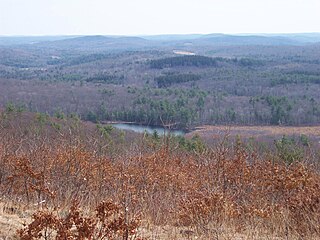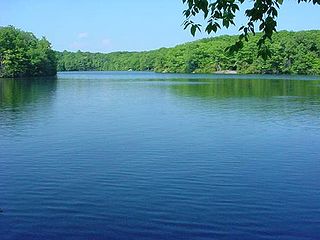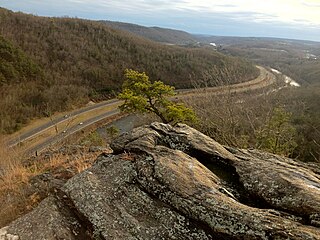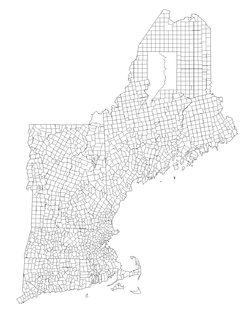
Mohawk State Forest, also known as Mohawk State Forest/Mohawk Mountain State Park, encompasses over 4,000 acres (1,600 ha) in the towns of Cornwall, Goshen, and Litchfield in the southern Berkshires of Litchfield County, Connecticut. As overseen by the Connecticut Department of Energy and Environmental Protection, the area is used for hiking, picnicking, and winter sports by the public, while being actively managed to produce timber and other forest products.

Lake Waramaug State Park is a 95-acre (38 ha) public recreation area located on the northwest shore of Lake Waramaug in the town of Kent, Litchfield County, Connecticut. The state park's first 75 acres (30 ha) were purchased by the state in 1920. The park offers swimming, fishing, picnicking, camping, and a launch for car-top boating and canoeing.

Millers Pond State Park is a public recreation area lying adjacent to Cockaponset State Forest in the towns of Durham and Haddam, Connecticut. The park's central feature is 33-acre (13 ha) Millers Pond, whose principal source of water is large springs that create a body of unpolluted water excellent for trout and smallmouth bass. The park offers fishing, hiking, mountain biking, and hunting.

Bigelow Hollow State Park is public recreation area in the town of Union, Connecticut, in the Quinebaug Highlands. The state park's 516 acres (209 ha) border Nipmuck State Forest on the east and west and Mashapaug Lake on the north. The park and forest are located in a large hollow or depression approximately 700' below the surrounding ridgelines. They are managed by the Connecticut Department of Energy and Environmental Protection.

Seth Low Pierrepont State Park Reserve is a public recreation area covering 305 acres (123 ha) in the town of Ridgefield, Connecticut. The state park offers opportunities for hiking, fishing, and boating.

Naugatuck State Forest is a Connecticut state forest consisting of five separate blocks in the towns of Oxford, Beacon Falls, Naugatuck, Bethany, Cheshire, Hamden, Seymour, and Ansonia. The five blocks are the Mount Sanford, East, West, Quillinan Reservoir, and Great Hill (Seymour) blocks.

Beaver Brook State Park is an undeveloped public recreation area covering 401 acres (162 ha) in the towns of Windham and Chaplin, Connecticut. The state park encompasses Bibbins Pond, also known as Beaver Brook Pond, as well as the acreage northward as far as the Air Line State Park Trail, which forms the park's northern boundary. The park is a walk-in facility, open for hunting and trout fishing, managed by the Connecticut Department of Energy and Environmental Protection.

Quaddick State Park is a public recreation area located on 203-acre (82 ha) Middle Quaddick Reservoir in the town of Thompson, Connecticut. The state park is managed by the Connecticut Department of Energy and Environmental Protection and offers opportunities for boating, swimming, fishing, and picnicking.

Platt Hill State Park is an undeveloped public recreation area occupying 159 acres (64 ha) in the town of Winchester, Connecticut. The state park has hiking trails, picnicking sites, and views of the surrounding area.

Stillwater Pond State Park is a public recreation area covering 226 acres (91 ha) in the town of Torrington, Connecticut. The state park surrounds Stillwater Pond, a 100-acre (40 ha) impoundment on the West Branch Naugatuck River. Fishing, boating, and a paved boat ramp are offered.

Hopemead State Park is an undeveloped public recreation area on the eastern shore of Gardner Lake, 8 miles (13 km) west of Norwich, Connecticut. The state park covers 60 acres (24 ha) in the towns of Bozrah and Montville and is managed by the Connecticut Department of Energy and Environmental Protection.

Pomeroy State Park is an undeveloped public recreation area covering 200 acres (81 ha) just south of Willimantic in the town of Lebanon, Connecticut. The state park is a forested area used for hiking and hunting with no entrance, markings, or parking that abuts preserved farmland. It is under the management of the Connecticut Department of Energy and Environmental Protection.

Becket Hill State Park Reserve is a public recreation area lying adjacent to Nehantic State Forest in the town of Lyme, Connecticut. The state park is as an undeveloped, walk-in park totaling 260 acres (110 ha) with no officially listed activities. It is managed by the Connecticut Department of Energy and Environmental Protection.

Hurd State Park is a public recreation area lying adjacent to George Dudley Seymour State Park on the east bank of the Connecticut River in the town of East Hampton, Connecticut. In addition to offering hiking, picnicking, and mountain biking, it is one of four Connecticut state parks that offer primitive camping for boaters on the Connecticut River.

Eagle Landing State Park is a public recreation area occupying 16 acres (6.5 ha) on the west bank of the Connecticut River in the town of Haddam, Connecticut. The state park has facilities for picnicking, fishing, and car-top boating. A private concessionnaire offers river excursions from a dock in the park.

George Dudley Seymour State Park is a public recreation area occupying 222 acres (90 ha) on the east bank of the Connecticut River in the town of Haddam, Connecticut. Hurd State Park abuts the park to the north. The park bears the name of George Dudley Seymour (1859-1945), whose philanthropic efforts enabled the state to purchase land for this and several other Connecticut state parks. It is managed by the Connecticut Department of Energy and Environmental Protection.

Higganum Reservoir State Park is a public recreation area occupying 147 acres (59 ha) on the banks of Higganum Reservoir in the town of Haddam, Connecticut. The state park offers fishing, hiking, hunting, and a launch area for car-top boating. It entered the state rolls as a 75-acre state park in the 1955 edition of the Connecticut Register and Manual.

James L. Goodwin State Forest is a Connecticut state forest covering approximately 2,000 acres (810 ha) in the towns of Chaplin and Hampton. The lands became public property when James L. Goodwin donated the personal forest he had been developing since 1913 to the state in 1964.

Nathan Hale State Forest is a Connecticut state forest encompassing 1,455 acres (589 ha) in the towns of Coventry and Andover. The forest is managed to sustain a reliable source of forest products and renewable habitat for wildlife. The forest originated in 1946 through the bequest of George Dudley Seymour, which allowed the state to purchase 850 acres in the surrounds of the historic Nathan Hale Homestead. In addition to cultivated plantations, the forest includes a 200-acre natural area that is kept without management activity. A 57-acre (23 ha) parcel, Creaser Park, is leased to the Town of Coventry for recreational use. The park offers hiking trails, fishing, and a dog-friendly area. Recreational usage in the rest of the forest includes hiking, hunting and letterboxing.

Nehantic State Forest is a publicly owned forest and recreation area occupying two parcels, one in the town of Lyme and one in the towns of East Lyme and Salem, in the state of Connecticut. The forest, which totals 5,062 acres (2,049 ha), is the site of regular prescribed burns and timber-harvesting operations. Purchase of the land began in 1926, when it became the first state forest located in New London County. It is managed by the Connecticut Department of Energy and Environmental Protection.


















